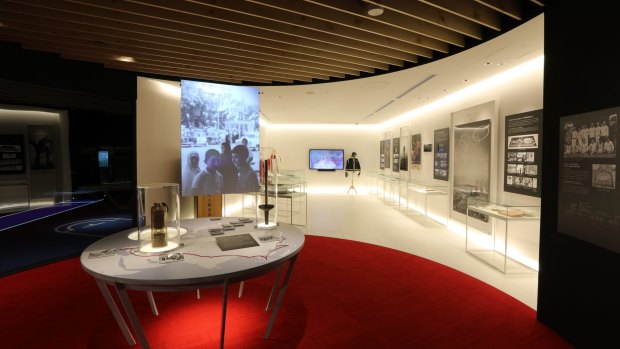This was published 4 years ago
Japan, Tokyo: The Japanese city rescued by the Olympics
By Anthony Dennis

The Japan Olympic Museum.Credit: Alamy
Rudy Giuliani, the erstwhile mayor of New York, once scoffed that the Olympics were exclusively for "cities on the make". Then, a few years later, New York lodged a bid, unsuccessfully as it transpired, for the Games, eclipsed by London for the 2012 hosting of the world's biggest peacetime event.
But if there was ever an Olympics that made, or perhaps remade, a city it was probably Tokyo, which first staged the Summer Olympics in 1964 and is set to do so again this July. The 1964 Olympics were momentous in that they heralded Japan's re-emergence into the world community after the shame and disgrace of its World War II defeat.
Remarkably, despite much of the country having been destroyed by Allied carpet and fire bombing, it managed to mount the Games just shy of two decades after the dropping of the catastrophic atomic bombs on Hiroshima and Nagasaki, the 75th anniversary of which will be marked this August.
If nothing else, the Tokyo 1964 Olympics were the clever games. They were, after all, a harbinger of Japan's technological might as seen in the shinkansen, or "new trunk line", better known as the now world-famous bullet train, as well as some groundbreaking modern architecture which redefined Olympic venue design.
Now some of those memories, including the 1964 Olympic torch, have been rekindled at the Japan Olympic Museum, opposite the bold new National Olympic Stadium, designed by Japanese "starachitect" Kengo Kuma. The stadium will be the venue for the Games' opening and closing ceremonies, athletics and football. OK. I admit it. I'm an Olympic tragic, and a Tokyo tragic, too, if the truth be known, but not just for the sports but for all the ceremony and culture that surrounds each Games.
The state-of-the-art museum, which opened late last year and is operated by the Japan Olympic Committee, traces all aspects of the Olympic Games from its origins in ancient Greece to the present day and beyond.
Tokyo, as I discover, was actually poised for Olympic glory as early as 1940 when it was due to host the Games following Nazi Berlin's in 1936 but forfeited it in 1938, diverted by its war in Manchuria, but not before a poster was designed and which is on display at the museum. The somewhat fearful-looking poster by Wada Senzo features the figure of a heroic athlete superimposed on to the figure of Nioh, the Benevolent King, familiar to the Japanese as the Buddhist temple gatekeeper who wards off evil spirits.
The first floor of the museum is dominated by a "welcome wall", consisting of arty Olympic rings created by Japanese school students, while upstairs, visitors can watch dynamic, big-screen footage of past Olympic opening and closing ceremonies, including those of Sydney 2000 and Melbourne 1956.
One of Japan's other innovations for the 1964 Games was its popularisation of pictograms which are still used at the Olympics to this day. The simple, stylised though immediately recognisable figures were designed to foster easier communications across the range of languages and cultures.
Fancy yourself as an Olympic athlete? The museum also includes fun displays that test your skills in various Olympic events as well as a display on Japan's considerable influence on the Olympics. What with Tokyo set to repeat the organisational triumph of last year's Rugby World Cup, it's one Olympic Museum exhibit that will surely need some considerable updating come the end of Tokyo 2020 on August 9.
TRIP NOTES
Anthony Dennis visited Tokyo as guest of the Japan National Tourism Organisation, Capitol Hotel Tokyu and Qantas.
MORE
VISIT
Japan Olympic Museum is open daily 10am-5pm and is located at Japan Olympic Square, 4-2 Kasumigaoka-machi, Shinjuku City, Tokyo. Entry to the first floor display is free; ¥500 to enter the main exhibit area. See japan-olympicmuseum.jp
The 2020 Tokyo Olympics run July 20-August 9 with the Tokyo 2020 Paralympics to follow, August 25-September 6. See tokyo2020.org
FLY
Qantas operates regular flights between Australia and Japan, including to Tokyo from Sydney and Melbourne. From March 29, subject to approval, Qantas will be the first Australian airline to offer daily year-round flights from Melbourne to Tokyo's preferred Haneda Airport. See qantas.com
STAY
Doubles at the upscale Capitol Hotel Tokyu start from ¥48,000 See tokyuhotelsjapan.com
Sign up for the Traveller Deals newsletter
Get exclusive travel deals delivered straight to your inbox. Sign up now.